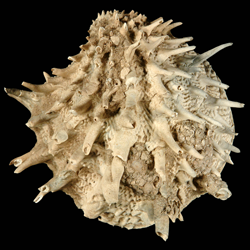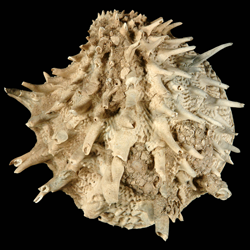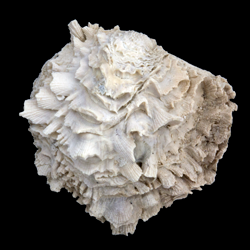
Chamidae

- Phylum: Mollusca
- Class: Bivalvia
- Order: Imparidentia
- Family: Chamidae
Overview
Common name: Jewelboxes or rock oysters
Key morphological features: The Chamidae range in size up to ~115mm. The shells are subcircular and irregular in outline, robust, and inequivalve. Most Chamidae species live cemented to hard substrates, but can be attached by either the left or right valve. In either case, the “lower” valve has a large attachment scar and is more inflated and larger than the flatter “upper” valve. The shell is composed of aragonite, and the exterior is rough and irregular, and covered in numerous, commarginal and/or radial, scaly spines in many species. Valve interiors have a simple, uninterrupted pallial line. Between the pallial line and the edge of the shell margin is a flat commissural shelf that, depending on the species, can be smooth or denticulate. Species of Chamidae are isomyarian or weakly heteromyarian, with the adductor muscle scars being dorsoventrally elongated and frequently with slight relief above the surrounding shell interior. The hinge is heterodont with one or two large cardinal teeth and weak lateral teeth, depending on the species, set in a robust, curved hinge plate. Source: Mikkelsen, P.M., and Bieler, R. 2008. Seashells of Southern Florida: Bivalves. Princeton, New Jersey: Princeton University Press. 503 pp.
Geological range: Cretaceous to Recent (Mikkelsen & Bieler, 2008).
Geographic distribution: A distributional map for modern Chamidae may be accessed from OBIS. A distributional map for ancient Chamidae may be accessed from the Paleobiology Database.
Diversity: There are 65 recognized living species of Chamidae and 6 genera (WoRMS database, unvetted). The Paleobiology Database recognizes 6 fossil genera and 150 fossil species of Chamidae (unvetted).
Paleoecology: The Chamidae are mostly sessile, epifaunal, marine, filter-feeding bivalves. Their shell exteriors are often colonized by epibionts and boring organisms. They inhabit clear, marine waters worldwide at temperate to tropical latitudes. Source: Mikkelsen and Bieler (2008).
Phylogenetic status: Unknown.

